-

人教版新目标初中英语九年级上册How do you study for a test教案2篇
内容提示本单元主要内容是学会利用verb十by/with gerund表示方式方法来讨论学习英语的策略,认识自己在学习方面的长处和不足。初步了解现在完成时的结构和用法。现在完成时由助动词have/has+动词的过去分词构成,主要表示过去发生的某一动作对现在仍有影响或造成的后果,常与already,yet,just,ever,never等副词连用。教学目标一、学习目标(Language Goal) 1. Talk about how to study . 学会讨论各种学习方法和策略。2. Find out your suitable learning methods. 找出适合自己的学习方法。 二、语言结构(Language Structures) 1. Verb + by with gerund by+动名词短语 表示“通过…途径,方法” 2. How questions have引导的特殊疑问句 三、目标语言(Target Language) 1. How do you study for tests ? 你是怎样准备考试的?Well , I study by working with my classmates. 哦,我和同学们一起学习。2. Have you ever studied with a group ? 你曾经参加过学习小组吗?Yes , I have . I’ve learned a lot that way . 是的,参加过。通过这种方式我学了许多。

人教版新目标初中英语九年级上册It must belong to Carla教案
一、Section A该部分有4个模块。第一模块围绕Whose volleyball is this? 这一话题展开思维( 1a)、听力(1b)、口语( 1c)训练;第二模块围绕上一模块中的话题进行听力( 2a-2b)、口语训练( 2c);第三模块继续围绕前两个模块中的“making inferences”展开训练。训练形式为阅读排序( 3a)和两人问答(3b);第四模块仍就上一话题展开讨论。二、Section B该部分有4个模块。第一模块要求根据图画和所提供的单词写出合理的句子;第二模块在听力( 2a-2b)和分角色口语训练( 2c)的基础上,继续进行“推测”训练; 第三模块围绕“Strange events in Bell Tower neighborhood”这一话题展开阅读( 3a)和写作(3b -3c)训练;第四模块以dream为话题展开小组活动。三、Self Check该部分有3个模块。第一模块以填空形式对所学词汇进行训练;第二模块就8个谚语展开阅读和讨论。

人教版新目标初中英语九年级上册Where would you like to visit教案2篇
The First PeriodⅠ.Teaching Aims and DemandsKnowledge Objects(1) Key Vocabularytiring, educational, fascinating, thrilling, peaceful, exotic, trek, jungle, take it easy, explore, historic, site(2) Target LanguageWhere would you like to go on vacation?I’d like to trek through the jungle, because I like exciting vacations.2. Ability Objects(1)Train students to talk about places they would like to visit with the target language.(2)Train students to describe vacations with different adjectives.(3)Train students' listening skill.3. Moral Object,It′s more interesting to go on vacating somewhere instead of staying at home.Ⅱ. Teaching Key Points1. Key Vocabularytiring, educational, fascinating, thrilling, peaceful, exotic, trek, jungle, take it easy, explore, historic, site2. Target LanguageTalk about different places with the target language.Ⅲ. Teaching Difficult Points1. Describe vacations with different adjectives.2. Talk about different places with the target language.Ⅳ. Teaching Methods1. Teaching by illumination2. Teaching by doing chain drills3. Teaching by pairworkⅤ. Teaching Aids1. A tape recorder2. Some pictures of different places with famous views

人教版新目标初中英语七年级上册My favorite subject is science教案
本单元主要学习一周中星期一到星期天的表达方式;掌握学科的表达;学习用because和表示品质的形容词表示理由;学习what,why,who引导的特殊疑问句。本单元围绕“谈论自己所喜欢的学科”这一话题,设计了三个任务型活动:任务一是:谈论自己所喜欢的学科,学习what引导的特殊疑问句和学科的表达;任务二是:一分钟演讲,让学生介绍自己喜欢某一学科的理由,学习why等特殊疑问句;任务三是:写信,巩固和延伸所学知识,掌握星期的表达方式。单元知识系统(树)What’s your/his/her favorite subject? My/His/Her favorite subject is English.Why do you like math. Because it’s interesting.Why does he/she like art? Because it’s fun.When do you have math? I have math 0n Monday,Wednesday and Friday.What’s Ken’s favorite subject? Science.单元总体目标通过本单元的学习使学生学会谈论自己喜好的学科或自己喜好的其它事情并给出理由;学会说出一周的七天;学会合理地安排自己的作息时间。

人教版新目标初中英语八年级上册How do you make a banana milk shake教案2篇
1. First, ... then, ... next, ... finally, ...首先,……然后,……接着,……最后,……这是英语中表达做某事的步骤的一种说法。如果步骤较多,还可以说:first-next-after that-later on-finally/at last通常你会听到说英语国家的人在说 first, next, then, finally 和后面的内容时,他们会做一些停顿。这样就能提前告诉听者接下来讲的是一系列的步骤。这一点在朗读和听力中应特别注意。2. how many, how much均为疑问词,同是“多少”,但用法不同。请看:how many修饰可数名词复数,how much修饰不可数名词。但在用法上,同学们常犯如下错误:1) [误] How many are there bananas on the table?[正] How many bananas are there on the table?[析] how many, how much 中的many,much是形容词,常修饰名词作定语,故后面跟名词。2) [误]How much tea are there on the table?[正]How much tea is there on the table?[析] how much修饰不可数名词时,谓语动词用单数。how many与how much的区别可简记为:前how many:问“多少”,复数名词后面跑;how much问“多少”,不可数名词单数好。前者答语用基数词,后者答语用数量关系。

人教版新目标初中英语八年级上册What’s the matter教案2篇
She shouldn’t go to the party tonight.Step7. TaskT: You know, there are lots of problems in our life. If you are a doctor, please tell us how to solve the problem. I will divide you into 9 groups. Please work in groups. And then choose one of you to report your ideas.The following are the problems:I have a toothache.I am hungry. I have a sore throat.I am stressed out. I have a sore back.I am tired. I can’t sleep.I have a cold. I have a headache.Report: If you have a headache, you should go to bed early. You should see the doctor. You should eat some medicine. You shouldn’t wash your face with cold water.You shouldn’t sleep late.You shouldn’t swim.…..T encourages the students to give advice as much as possible.Homework:1. Chose one of the problems, and write down your advice2. Copy the new words这一步是用于热身的,同时也可以让他们复习一部分的表示人体部位的单词,扩充知识.学习语言的过程也是一个不断积累的过程,复习旧知识,增添新知识.通过小游戏,强化学生对Does she/he have…这个句子的运用能力.通过复习,自然的引到下面新知识的学习。充分利用表格,由句子到对话,再到文章,让学生循序渐进. 提高学生的综合语言运用能力,运用以前学过的知识来解决身边的问题.Period 5 (Section B 3a—3c, selfcheck)教学内容与分析:

人教版新目标初中英语九年级上册Teenagers should be allowed to choose their own clothes教案2篇
Step 1 Greeting Greet the class and check the homeworkStep 2 A duty report The S on duty gives a report on the rules in his home and lead in 3a “Sun Fei’s and Wu Yu’s rules” Step 3 ReadingSs read the conversation and write the two girls’ rules in the chart. Check the answers.Get Ss to read after the tape and then read aloud by themselves. Then, T explains the language points.Step 4 Pairwork 3bRole play. Use the information in chart to practice with the conversation in 3a covered. They can look at the sample conversation in the right box.Step 5 Task 2 “Who’s the best reporter?”Make a survey by asking any 5 students the questions in the chart in activity 4. Then give out a report about it. See who is the best reporter? And the best reporter will get a nice ball-pen.Step 6 Summary and homework:Write out the report in your exercise-books.Period ThreeStep 1 Greeting and a duty reportThe S gives a duty report talking about his experience of being late for school. Lead in the question “Do you ever get to school late? How often do you get to school late? Always, usually, sometimes, or never?Step 2 1a Get Ss to finish writing.Step 3 Pairwork 1b Get Ss to talk about their answers with their partners using the sample conversation in the box on the right.Step 4 Listening practice2a Lead-in: What will happen if you get to school late? What about Peter? Let’s listen to a conversation between Peter and his father. Get Ss to finish 2a (As usual, for the first time, Ss only listen.) Check the answers.

人教版新目标初中英语九年级上册I like music that I can dance to教案
教学目标: 1. Express preferences2. Talk about one’s likes and dislikes and the reasons3. Learn to express one’s opinions 4. Learn to write a reply 语言功能: 1) Talk about one’s preferences, using t he relative clause2) Talk about people’s likes and dislikes and the reasons3) Talk about opinions语言结构: Relative clauses with that and who语言目标:What kind of music do you like?I like music that I can sing along with.I love singers who write their own music.We prefer music that has great lyric.重点词汇及短语:heart, photography, interest, class, whatever, miss, okay, expect, sweet, taste, itself, laboratory, cancer, increase, biscuit, main, care, prefer… to…, remind somebody of …, dance to, sing along with, be sure to, interest somebody, make somebody adj., to be honest, suit somebody, on display, catch up教学重难点:What do other people think of the different kinds of things? How to express one’s opinions? 学习方式:讨论,合作学习情感目标:通过本单元的学习,能提高学生的艺术鉴赏能力和审美情趣,并引导学生养成健康的饮食习惯。课时安排5课时第一课时:Section A: 1a-2c第二课时:Section A : 3a-4第三课时:Section B:1-2c, Self check2第四课时:Section B: 3a-4, Self check1第五课时:Self check ReadingI like music that I can dance to.

人教版新目标初中英语九年级上册I used to be afraid of the dark教案
内容提示1.本单元主要内容是学会used to结构。Used to +动词原形表示过去经常、以前常常,只用于过去式中,用来表示现在已不存在的习惯或状态。例如:They used to play football together.他们过去常在一起蹋足球。(现在不在一起踢了)2.used to的疑问形式和否定形式为Did you use to…?和I didn’t use to… 也可以用Used you to…?和I used not to…但现在多使用前者。例如:Did you used to swim in the river? 你过去常在河里游泳吗?I didn’t use to play the piano. 我以前并不经常弹钢琴。教学目标一、学习目标(Language Goal) 1.学会陈述自己过去常做的事情。2.学会陈述自己过去的爱好等。3.能够表达自己现在和过去在外表、性格、娱乐等方面的变化。4.能够表达朋友、家人等现在和过去的变化。二、语言结构(Language Structures) 1.I used to be short when I was young. 我年轻时个子很矮。 2. —Did you use to have straight hair? 你过去是直发吗?—Yes, I did. 是的。 3. —Did you use to play the piano? 你过去弹钢琴吗?—No, I didn’t. 不,我不弹。 4.I used to be afraid of dark. 我过去害怕黑暗。 5.I’m terrified of the snakes. 我害怕蛇。
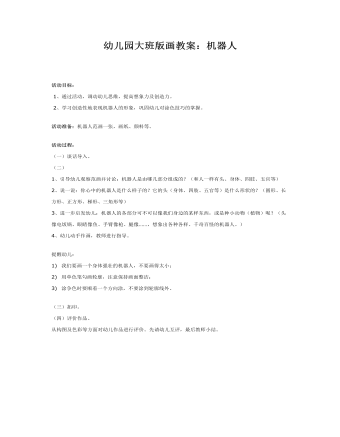
幼儿园大班版画教案:机器人
活动过程:(一)谈话导入。 (二) 1、引导幼儿观察范画并讨论:机器人是由哪几部分组成的?(和人一样有头、身体、四肢、五官等) 2、说一说:你心中的机器人是什么样子的?它的头(身体、四肢、五官等)是什么形状的?(圆形、长方形、正方形、梯形、三角形等) 3、进一步启发幼儿:机器人的各部分可不可以像我们身边的某样东西,或是种小动物(植物)呢?(头像电饭锅、眼睛像鱼、手臂像枪、腿像……,想象出各种各样、千奇百怪的机器人。) 4、幼儿动手作画,教师进行指导。
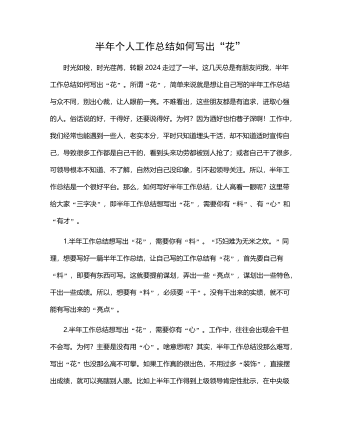
半年个人工作总结如何写出“花”
其实,半年工作总结没那么难写,写出“花”也没那么高不可攀。如果工作真的很出色,不用过多“装饰”,直接摆出成绩,就可以亮瞎别人眼。比如上半年工作得到上级领导肯定性批示,在中央级媒体刊发介绍经验,在全国荣获先进,得到群众高度认可等等。当然,大多单位不可能有那么多荣誉,怎么办?这就要用心找。比如分析一下半年数据,是不是比去年同期有大幅提升。看看获得的荣誉,看有没有中央、省等荣誉。看特色,有没有工作得到领导高度认可等,群众高度称赞。只要用“心”挖,一定会写出一篇有特点的半年工作总结。3.半年工作总结想写出“花,需要你有“才”。工作有了“料”,用“心”发现了“亮点”,可是没有“才”,最终还是不能写出一篇有“花”的半年工作总结。这里“才”简单来说,就是要有“写作”能力,有亮点能概括,有想法能写得出来等等。总之,想要写好半年工作总结需要“料、心、才”具备才行。

新人教版高中英语必修3Unit 2 Morals and Virtues教学设计四
3.Teachers ask different groups to report the answers to the questions and ask them to try different sentence patterns.The teacher added some sentence patterns for students to refer to when writing.Step 4 Writing taskActivity 51.Write the first draft.Students first review the evaluation criteria in activity 5, and then independently complete the draft according to the outline of activity 4, the answers to the questions listed in the group discussion and report, and the reference sentence pattern.2.Change partners.The teacher guides the students to evaluate their partner's composition according to the checklist of activity 5 and proposes Suggestions for modification.3.Finalize the draft.Based on the peer evaluation, students revise their own compositions and determine the final draft.Finally, through group recommendation, the teacher selects excellent compositions for projection display or reading aloud in class, and gives comments and Suggestions.Step 5 Showing writingActivity 5T call some Ss to share their writing.Step 6 Homework1. Read the passage in this section to better understand the passage.2. Carefully understand the hierarchical structure of the article, and deeply understand the plot of the story according to the causes, process and results;3. Independently complete the relevant exercises in the guide plan.1、通过本节内容学习,学生是否理解和掌握阅读文本中的新词汇的意义与用法;2、通过本节内容学习,学生能否通过人物言行的对比分析道德故事的深层内涵;3、通过本节内容学习,学生能否根据故事的起因、经过和结果来深入理解故事的情节,从而了解文章的层次结构;4、结合现实生活案例发表自己的见解和看法,写一篇观点明确、层次分明的故事评论。

新人教版高中英语必修3Unit 3 Diverse Cultures教学设计四
该板块的活动主题是“介绍一个有显著文化特征的地方”( Describe a place with distinctive cultural identity)。该板块通过介绍中国城继续聚焦中国文化。本单元主题图呈现的是旧金山中国城的典型景象, Reading and Thinking部分也提到中国城,为该板块作铺垫。介绍中国城的目的主要是体现中国文化与美国多元文化的关系,它是美国多元文化的重要组成部分。中国城也是海外华人的精神家园和传播中国文化的重要窗口,外国人在中国城能近距离体验中国文化。1. Read the text to understand the cultural characteristics of Chinatown in San Francisco and the relationship between Chinese culture and American multiculturalism;2. Through reading, learn to comb the main information of the article, understand the author's writing purpose and writing characteristics;3. Learn to give a comprehensive, accurate, and organized description of the city or town you live in;Learn to revise and evaluate your writing.Importance:1. Guide the students to read the introduction of Chinatown in San Francisco and grasp its writing characteristics;2. Guide students to introduce their city or town in a comprehensive, accurate and organized way;3. Learn to comb the main information of the article, understand the author's writing purpose, and master the core vocabulary.
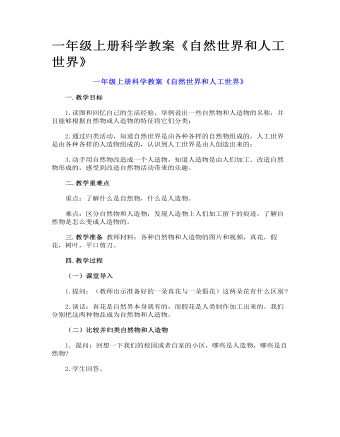
一年级上册科学教案《自然世界和人工世界》
把自然物改造成人造物 1.提问:请小组展示作品,并请别的同学推想这件作品是怎样被改造出来的?我们改造后的树叶是什么样子的?而改造前的树叶又是什么样子的?(教师引导学生思考并说出自然物变成人造物的过程,采用倒推的方式,结合现实中的人造物,去推想制成它的原材料,以及这些原材料在自然界中本来的样子。) 2.提问:生活中还有哪些物品,由自然物被制造成了人造物。(如:演示经过加工变成了石碑或石雕;木头经过加工变成了木槌;兽皮经过加工变成了皮衣等等)
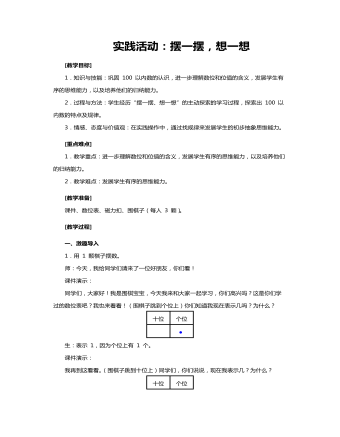
人教版一年级数学《实践活动摆一摆,想一想》教案
[教学目标]1.知识与技能:巩固 100 以内数的认识,进一步理解数位和位值的含义,发展学生有序的思维能力,以及培养他们的归纳能力。2.过程与方法:学生经历“摆一摆、想一想”的主动探索的学习过程,探索出100 以内数的特点及规律。3.情感、态度与价值观:在实践操作中,通过找规律来发展学生的初步抽象思维能力。[重点难点]1.教学重点:进一步理解数位和位值的含义,发展学生有序的思维能力,以及培养他们的归纳能力。2.教学难点:发展学生有序的思维能力。[教学准备] 课件、数位表、磁力扣、围棋子(每人3 颗)。[教学过程]一、激趣导入1.用 1 颗棋子摆数。师:今天,我给同学们请来了一位好朋友,你们看!课件演示:同学们,大家好!我是围棋宝宝,今天我来和大家一起学习,你们高兴吗?这是你们学过的数位表吧?我也来看看!(围棋子跳到个位上)你们知道我现在表示几吗?为什么?生:表示 1,因为个位上有 1 个。
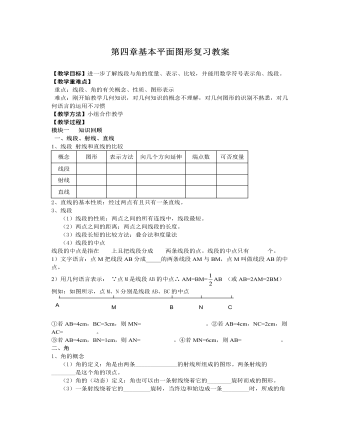
北师大初中七年级数学上册第四章复习教案
1、如图,OA、OB是两条射线,C是OA上一点,D、E是OB上两点,则图中共有 条钱段、它们分别是 ;图中共有 射线,它们分别是 。2、如果线段AB=5cm,BC=3cm,那么A、C两点间的距离是 3、(1)用度、分、秒表示48.26° (2)用度表示37°28′24″ 4、从3点到5点30分,时钟的时针转过了 度。5、一轮船航行到B处测得小岛A的方向为北偏西30°,则从A处观测此B处的方向为( ) A. 南偏东30° B. 东偏北30° C. 南偏东60° D. 东偏北60°6、已知,OA⊥OC,∠AOB∶∠AOC=2∶3,则∠BOC的度数为( )A. 30° B. 150° C. 30°或150° D. 不同于上述答案7、如图,AO⊥OB,直线CD过点O,且∠BOD=130°,求∠AOD的大小。8、已知:如图,B、C两点把线段AD分成2∶4∶3三部分,M是AD的中点,CD=6,求:线段MC的长。9、平面上有n个点(n≥2)且任意三个点不在同一直线上,经过每两个点画一条直线,一共可以画多少条直线?迁移:某足球比赛中有20个球队进行单循环比赛(每两队之间必须比赛一场),那么一共要进行多少场比赛?
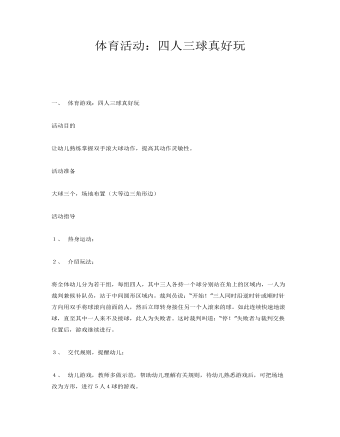
大班体育游戏:四人三球真好玩课件教案
让幼儿熟练掌握双手滚大球动作,提高其动作灵敏性。活动准备大球三个,场地布置(大等边三角形边)活动指导1、 热身运动;
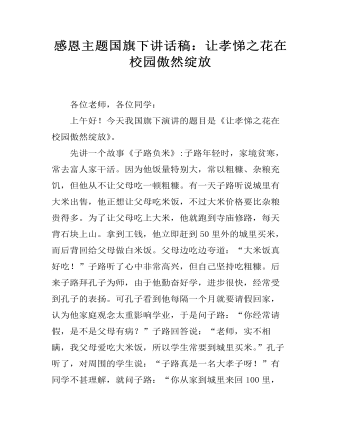
感恩主题国旗下讲话稿:让孝悌之花在校园傲然绽放
各位老师,各位同学:上午好!今天我国旗下演讲的题目是《让孝悌之花在校园傲然绽放》。先讲一个故事《子路负米》:子路年轻时,家境贫寒,常去富人家干活。因为他饭量特别大,常以粗糠、杂粮充饥,但他从不让父母吃一顿粗糠。有一天子路听说城里有大米出售,他正想让父母吃米饭,不过大米价格要比杂粮贵得多。为了让父母吃上大米,他就跑到寺庙修路,每天背石块上山。拿到工钱,他立即赶到50里外的城里买米,而后背回给父母做白米饭。父母边吃边夸道:“大米饭真好吃!”子路听了心中非常高兴,但自己坚持吃粗糠。后来子路拜孔子为师,由于他勤奋好学,进步很快,经常受到孔子的表扬。可孔子看到他每隔一个月就要请假回家,认为他家庭观念太重影响学业,于是问子路:“你经常请假,是不是父母有病?”子路回答说:“老师,实不相瞒,我父母爱吃大米饭,所以学生常要到城里买米。”孔子听了,对周围的学生说:“子路真是一名大孝子呀!”有同学不甚理解,就问子路:“你从家到城里来回100里,难道不辛苦吗?”子路说:“双亲年迈,能给他们一点满足,表达儿子的一片孝心,这是老师平日里对我们的教导。回家背米,虽然很辛苦,但只要想到老人得到安慰,我就会精神百倍。”

XX年春开学第四周国旗下讲话:创建绿色校园
我们大家都知道大地上站立的最大的生命群体是森林,大地上最悦目的颜色是绿色,绿色是大自然赠与我们人类的宝贵财富,绿色是人类文明的摇篮。人人都渴望拥有一个美好的家园,人人都希望生活在人与自然和谐发展的文明环境里。如今我校各方面的建设有序的进行着,我们的校园环境也正在发生全面的变化,校园环境建设是我们金源师生必须直面的问题,校园绿化程度直接作用于我们的生活环境,决定着校园生活的色彩,当然,绿色校园不只是环境绿化与垃圾处理问题,其涵义应更广更深,指一种健康向上的生活态度和生活方式,比如,严肃活泼的学术氛围,积极进取的精神风貌等。创建绿色校园,不仅只是要有优美的硬件环境,更应该提高我们自身的修养和素质,因此我们每一个金源学子都应成为护绿天使,用我们的实际行动去影响周围的人。结合学校‘三育’教育在此我提出以下几点倡议:
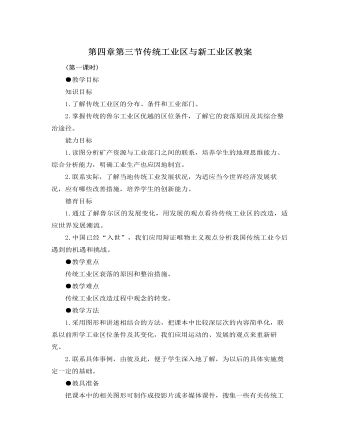
人教版新课标高中地理必修2第四章第三节传统工业区与新工业区教案
知识目标1.了解传统工业区的分布、条件和工业部门。2.掌握传统的鲁尔工业区优越的区位条件,了解它的衰落原因及其综合整治途径。能力目标1.读图分析矿产资源与工业部门之间的联系,培养学生的地理思维能力、综合分析能力,明确工业生产也应因地制宜。2.联系实际,了解当地传统工业发展状况,为适应当今世界经济发展状况,应有哪些改善措施,培养学生的创新能力。德育目标1.通过了解鲁尔区的发展变化,用发展的观点看待传统工业区的改造,适应世界发展潮流。2.中国已经“入世”,我们应用辩证唯物主义观点分析我国传统工业今后遇到的机遇和挑战。


